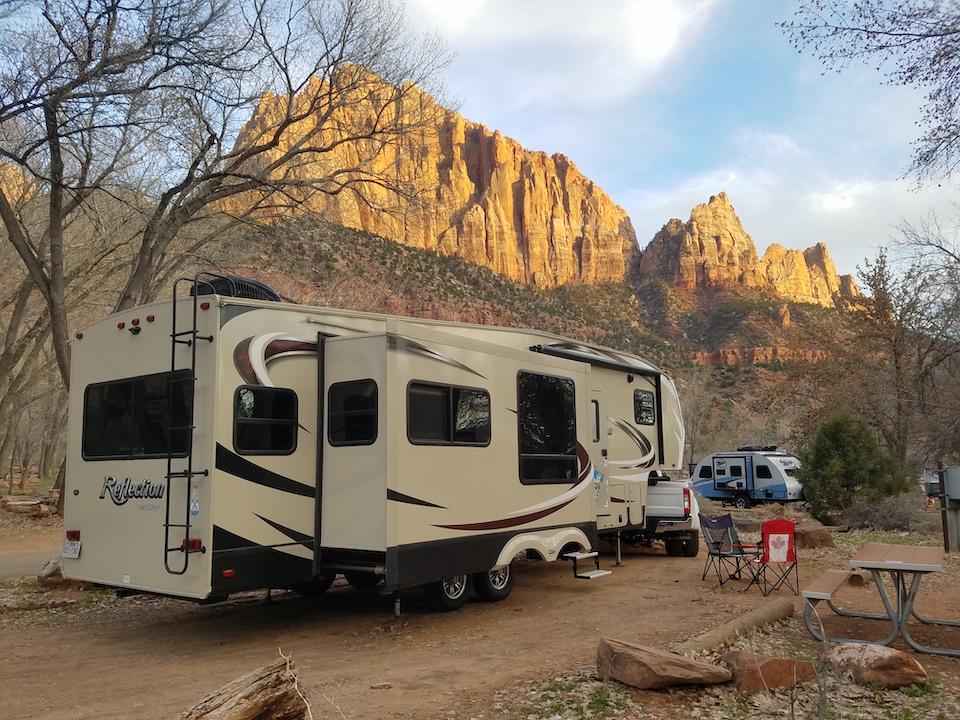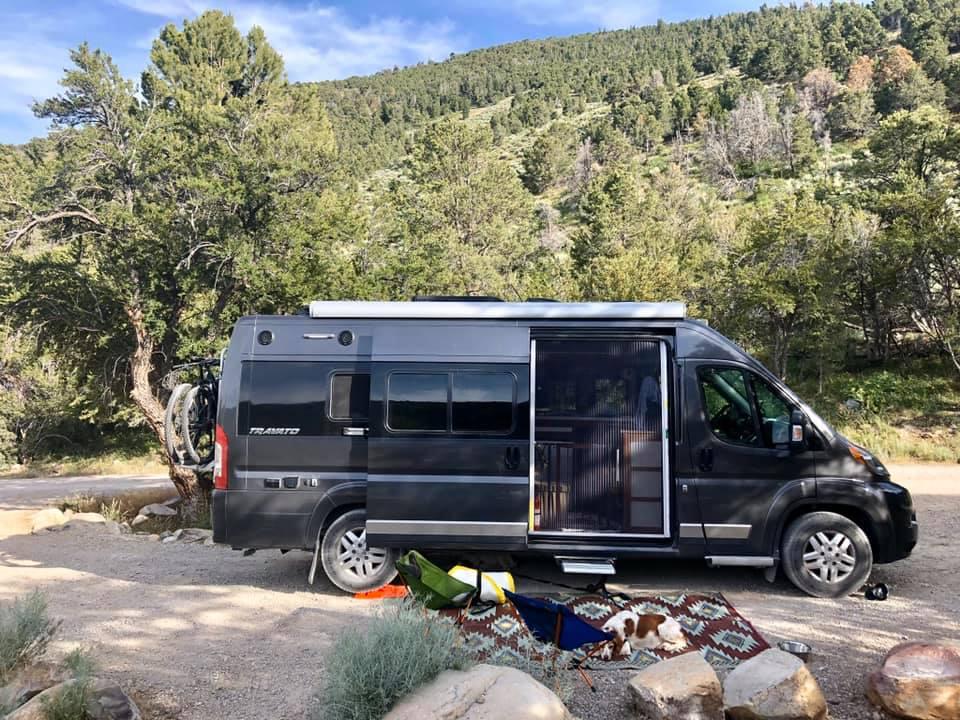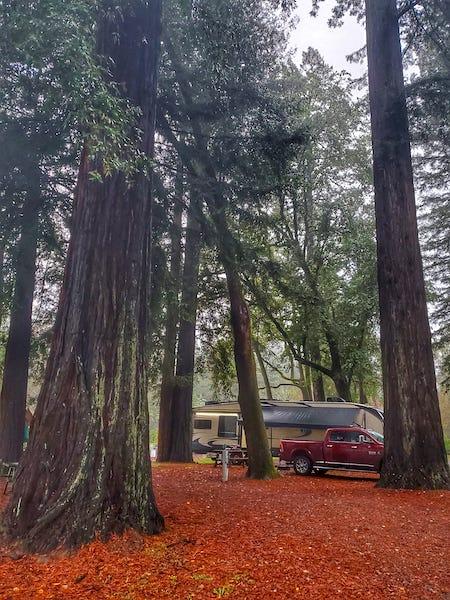
Different sized RVs have different issues when it comes to national park campgrounds/Pat Williams "Cletch"
“Baker Creek, that’s the one!” I said to my husband as he slowed down for the turn. “It’s that dirt road.” He looked at the sharp climb into the forest, then at me, and shook his head. Maybe it wasn’t the best national park for an RV like ours after all.
“Are you sure this is where you want to go?” Yes, I said, I was. Or at least I thought so. My cursory trip research gave me confidence that at least a few of the sites at Great Basin National Park in Nevada could accommodate our 42-foot-long rig. Three miles later as we bounced along that bumpy, narrow road into the campground, we were reminded that sometimes spontaneity has a price.
The Campground Conundrum for RVers
The rustic accommodations of national park campsites get us closer to nature than private campgrounds outside the park. But opting for that primitive experience often puts RVers like you and me in the middle of that classic Goldilocks conundrum. Without good planning, we just don’t know if a campground can easily accommodate our home on wheels. I can’t count the number of times we have spent an entire afternoon jumping from one open site to another, trying each one on for size until we found the one that fits just right – if we were lucky enough to find one at all.
As the owner of a medium-sized fifth wheel, I’m always slightly envious when I see truck campers, vans, and small motorhomes tucked away in a cozy gem of a campsite that could never accommodate my rig. The truth is, bigger is not always better when it comes to RVing in national parks. The smaller your rig, the more campsite choices you have, including some amazing backcountry campsites where large rigs would never tread.
It’s often said that the best RV type for national parks is a unit that’s 30-feet long or less, including the tow (or towed) vehicle. I agree, since the short, narrow parking aprons in most national park campgrounds make navigation difficult in anything bigger. That’s not to say your 40-foot motorhome won’t ever be able to camp in national parks, it just means that you’ll need to work harder to find a great campsite.
How to find the best national park campsite for your RV
If you’re one of America’s nine million RV owners and have your heart set on a national park experience, prepare to reserve a spot as far in advance as possible at Recreation.gov. Wherever you roam in the park system, the RV-friendly spots are always the first to go. Spontaneous travel offers some amazing benefits, but showing up at a national park's campground without a reservation is a recipe for disappointment. For example, two years ago we showed up at Yellowstone in October without a reservation and learned the hard way that the “off-season” is a thing of the past. There wasn’t a single site open inside the park for an RV our size.
Compared to most RVs, ours is pretty small. The fifth wheel itself is only 27-feet long, but when hitched to our pickup truck it’s a 42-foot long rolling home that sometimes makes campsite parking a crazy experiment in communication, patience, and skill. Many owners of RVs larger than ours are successful at squeezing into the pint-sized campsites at national parks, but we prefer to avoid being the afternoon entertainment when we land somewhere.

Take a long RV into Great Basin's Baker Creek Campground and you could be squeezed for space. Smaller rigs rule there/Kate Gallagher
To listen to this story, download our upcoming podcast, episode 53, on February 23, 2020.
From Joshua Tree to Black Canyon of the Gunnison and beyond, we’ve learned that planning pays off for national park RV camping, and it’s easier now that we know the answers to these questions:
Will the campground accommodate my needs?
If your RV is self-contained with holding tanks, toilet facilities, and perhaps solar electric power, you can go just about anywhere. But if you’re in a more basic rig without them, a designated campground with water and bathroom facilities is a smart idea. And if you rely on generator power, you’ll need a campground that allows their use. Not all do in the park system, so always verify that the one you want to visit has generator hours and other creature comforts you want.
What is the length of my RV?
Don’t rely on the RV manufacturer’s sticker to tell you the length of your rig. That number usually only factors in the interior length dimension of the RV, instead of the exterior measurement from front to back bumper. Your tow vehicle, or towed car, adds additional length that impacts where you can camp. To find out your actual length, get your RV measured. You want to know the total number of feet for your RV and secondary vehicle, if any. If you don’t know the length of your rig when you’re rolling down the highway, now’s the time to grab a surveyor’s tape measure and figure it out. Measure from the front bumper of the first vehicle to the back bumper of the second one. If you have bicycles or a cargo box hitched to the rear, add those in too. Also measure the height from the highest point on your roof, and total width with slides extended, if applicable. Many campsites have thick tree canopies with limited clearance for tall vehicles, and some national park campground websites will let you know if they do.
What is the maximum RV length for the campsite I want?
You’ll see that number for every campsite on Recreation.gov, but it only refers to the vehicle being parked at the site. To accommodate for turning radius and parking technicalities of various RV styles, many back-in sites will have different length restrictions for trucks, vans, motorhomes, and towables. A towable is typically allowed five fewer feet parking space in a campsite than a motorhome, to account for turning radius. If you see that a site has a 35-foot maximum length for a motorhome, the longest fifth wheel it can easily accommodate will probably be 30-feet long. Also, you may or may not be able to fit a second vehicle on the parking apron. Before reserving a spot, call the park to get a better idea of the campground’s ease of use for an RV like yours.

National park campgrounds often bring you closer to nature than private campgrounds outside the parks/Olga Davis
Do parking hazards exist?
Even when site dimensions look acceptable, natural obstacles may prevent you from getting into the spot. If there’s any question about getting into a site before you book online look carefully at Recreation.gov photos or download a Google Earth map to confirm that you can fit your vehicle and your RV into that space without scraping a tree or boulder. If you’re already at the campground, observe and note if the rig’s back end will hang over the parking apron or smash into neighboring landscaping. Many RVers squeeze into a site that’s technically too short for their RV, by hanging the rear end off the parking apron. If you’re tempted to try it, be aware that staff may or may not look the other way.
In the RV community, many people will say that a small RV is best for one location, while a vocal contingent of super-sized RV owners will say they don’t have a problem accessing that same spot. As with many things, the truth lies somewhere in the middle.
A Lasting Reminder
In addition to great scenery, our trip to the Baker Creek Campground at Great Basin also had a learning experience in store. We survived the dirt road getting there, but our hopes for a great site disappeared when we discovered that the biggest campsites were taken. The deeper we drove into the campground, the more frustrated we grew after seeing that most sites were just too short for our rig. Finally, we found a spot constructed along an awkwardly curved parking apron. But it had tall trees on either side that warned of disastrous consequences for any RVer dumb enough to park there. With no options left, we were the next victims and quickly acquired a deep pinstripe scratch for a souvenir. Today, it’s a constant reminder to do more homework before RVing into any national park.



Comments
Nice job Rene. We've been faced with similar dilemmas when trying to park. Your reference to Google Maps is spot on as this is know the go to method of verifying access. But in the end aplan is just the starting point.
Is there a link to the National Parks RV Campsite Chart in the article. If so, I missed it.
Sorry Michael, that was an editing error. The chart is not ready for prime time.
Having volunteered in national parks and having looked at the sites in those parks day after day, I can assure you that there is no document that will have the correct site length for every site in every national park. The sites typically aren't all measured. They are 'guesstimates' and many times 'guesstimates' by a person who is not a RVer. It also depends a lot on how capable a driver is in getting into sites. We RV'd with a 40' motorhome and fit into many of the popular national parks even though their site size said otherwise.
How's it going? I have a question before I buy a 24 foot trailer. These restrictions in the National Park talk about the truck and the trailer combined. Can I just put the trailer in a 40 foot limit spot and park the truck somewhere else? So just the RV counts? Because the truck is 19 feet. Thanks.
John Burger
[email protected]
John, not sure you always could find another place to park your rig.
Funny, I just returned from Baker Creek Campground and read your post. I do have a great tip. I never book a campsite without looking on the website Campsitephotos.com. You can't find every campground on the site, but many are there. They suggest the "best" campsites at the one you are interested in and so I look at those photos first. Of course, the recommended site may be for a tent and not a fifth wheel. I always look at the photo to see if the picnic table and fire ring are on the same side as my trailer door. Does the site look like it has privacy? Can I fit my truck in, or do I have to unhook and park sideways? The Baker Creek sites were listed there and I never head out to a camp without checking camlsitephotos.com first. Happy trails!
I'm confused on the google maps reference? What are we to look for? We're newly retired and new to the RV world. and need all the help we can get!